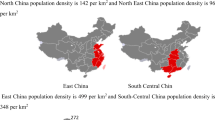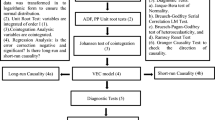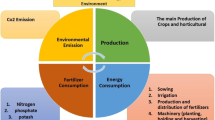Abstract
An important breakthrough in the coordinated development of China’s low-carbon goals and food security strategies is agricultural development oriented toward quality, safety, green, and low carbon. This study integrated command-control and market-incentive environmental regulation (ER), agricultural eco-efficiency (ACEE), and food quality and safety (FQS) into a unified theoretical framework. The unexpected output-oriented Super-SBM model was used to calculate the ACEE of China’s provinces and cities from 2011 to 2020 and test the bidirectional causality between ACEE and FQS through the system generalized moment estimation model. A dynamic panel smooth transition (PSTR) model was used to explore the nonlinear impact mechanisms of different types of ERs on ACEE and FQS. The results showed that there was a long-term, two-way causal relationship between ACEE and FQS. The impact of environmental regulations on ACEE and FQS has a nonlinear relationship. Among them, the role of market-incentivized ER is more significant. Therefore, building an interregional coordinated development mechanism, improving the utilization rate of agricultural resources such as fertilizers and pesticides, and coordinating the positive effects of different types of ERs are the keys to improving the ACEE and ensuring the coordinated development of FQS.

Similar content being viewed by others
Data availability
Data available on request from the authors.
References
Altman M (2001) When green isn’t mean: economic theory and the heuristics of the impact of environmental regulations on competitiveness and opportunity cost. Ecol Econ 36:31–44
Andrade JF, Satorre EH (2015) Single and double crop systems in the Argentine Pampas: environmental determinants of annual grain yield. Field Crop Res 177:137–147
Aquino HV, Yap T, Lacap JPG et al (2021) Food safety knowledge, attitudes, practices and training of fast-food restaurant food handlers: a moderation analysis. British Food Journal 123:3824–3840
Asadullah MN, Kambhampati U (2021) Feminization of farming, food security and female empowerment. Glob Food Sec 29:100532
Barbera AJM, Virginia D (1990) The impact of environmental regulations on industry productivity: direct and indirect effects. J Environ Econ Manag Elsevier 18(1):50–65
Blundell R, Bond S (1998) Initial conditions and moment restrictions in dynamic panel data models. J Econ 87(1):115–143
Chao Feng C-JZ, Shan M-L (2020) The clarification for the features, temporal variations, and potential factors of global carbon dioxide emissions. J Clean Prod 255:120250
Chen H, Hao Y, Li J et al (2018) The impact of environmental regulation, shadow economy, and corruption on environmental quality: theory and empirical evidence from China. J Clean Prod 195:200–214
Chen Yuke LL, Jingrong D (2022) Environmental regulation tools, regional differences and enterprise green technology innovation: China’s provincial data analysis based on systematic GMM and dynamic thresholds. Sci Res Manag 43(04):111–118
Duan H, Zhang Y, Zhao J et al (2011) Carbon footprint analysis of farmland ecosystem in China. J Soil Water Conserv 25:203–208
Ericksen PJ, Ingram JSI, Liverman DM (2009) Food security and global environmental change: emerging challenges. Environ Sci Policy 12:373–377
Gonzalez A, Teräsvirta T, Van Dijk D, Yang Y (2017) Panel smooth transition regression models
Hou Q, Guan Y, Yu S (2020) Stochastic differential game model analysis of emission-reduction technology under cost-sharing contracts in the carbon trading market. Ieee Access 8:167328–167340
Huang X, Tian P (2023) How does heterogeneous environmental regulation affect net carbon emissions: spatial and threshold analysis for China. J Environ Manage 330:117161
Hurmuzache T, Iancu M, Iancu T et al (2015) Aspects that characterize the structure of consumption of agricultural products, at national level. J Biotechnol 208:S80–S80
Jiang T, Liu, T, Dong W, Liu Y, Zhang Q (2022) Security risk level prediction of carbofuran pesticide residues in chinese vegetables based on deep learning. Foods 11(7):1061
Jinkai Li MG, Luo E, Wang J, Zhang X (2023) Does rural energy poverty alleviation really reduce agricultural carbon emissions? The case of China. Energy Econ 119:0140–9883
Kotsanopoulos KV, Arvanitoyannis IS (2017) The role of auditing, food safety, and food quality standards in the food industry: a review. Comp Rev Food Sci Food Saf 16:760–775
Kuiper M, Cui HD (2021) Using food loss reduction to reach food security and environmental objectives-a search for promising leverage points. Food Policy 98:101915
Lee HS (2021) Slacks-based measures of efficiency and super-efficiency in presence of nonpositive data. Omega-Int J Manag Sci 103:102395
Lena D, Pasurka CA, Cucculelli M (2022) Environmental regulation and green productivity growth: evidence from Italian manufacturing industries. Technol Forecast Soc Chang 184:121993
Li Bo ZJ, Haipeng Li (2011) Spatial and temporal characteristics of China’s agricultural carbon emissions and decomposition of influencing factors. China Popul Resour Environ 21:80–86
Li Z, Li J (2022) The influence mechanism and spatial effect of carbon emission intensity in the agricultural sustainable supply: evidence from China’s grain production. Environ Sci Pollut Res 29:44442–44460
Niu HY, Zhang ZS, Xiao Y, Luo M, Chen Y (2022) A study of carbon emission efficiency in Chinese provinces based on a three-stage SBM-undesirable model and an LSTM model. Int J Environ Res Public Health 19(9):5395
Pang J, Li H, Lu C, Lu C, Chen X (2020) Regional differences and dynamic evolution of carbon emission intensity of agriculture production in China. Int J Environ Res Public Health 17(20):7541
Penghao Wang ZL (2023) Strategic interaction in environmental regulation and sulfur dioxide emissions: evidence from China. Sci Total Environ 875:0048–9697
Ploeg FWC (2012) Is there really a green paradox? J Environ Econ Manag 64(3):342–363
Porter ME, Vanderlinde C (1995) Toward a new conception of the environment-competitiveness relationship. J Econ Perspect 9:97–118
Ramanathan RHQ, Black A et al (2016) Environmental regulations, innovation and firm performance: a revisit of the Porter hypothesis. J Clean Prod 155(PT.2):79–92
Reinhard S, Lovell CAK, Thijssen G (1999) Econometric estimation of technical and environmental efficiency: an application to Dutch dairy farms. Am J Agr Econ 81:44–60
Rude J, Weersink A (2018) The potential for cross-compliance in Canadian agricultural policy: linking environmental goals with business risk management programs. Can J Agric Econ -Revue Canadienne D Agroeconomie 66:359–377
Searchinger TD, Wirsenius S, Beringer T et al (2018) Assessing the efficiency of changes in land use for mitigating climate change. Nature 564:249
Shen ZY, Wang SK, Boussemart JP, Hao Y (2022) Digital transition and green growth in Chinese agriculture. Technol Forecasting Soc Change 181:121742
Sheng Jiping MJ, Yu B, Wang Z (2021) How does blockchain technology enable collaborative innovation and development of agriculture: functional characteristics, efficiency mechanism and management mechanism. China Rural Econ 12:22–43
Teets JC, Gao M, Wysocki M et al (2021) The impact of environmental federalism: an analysis of watershed eco-compensation policy design in China. Environ Policy Gov 31:580–591
Tenorio FAM, McLellan EL, Eagle AJ et al (2020) Benchmarking impact of nitrogen inputs on grain yield and environmental performance of producer fields in the western US Corn Belt. Agr Ecosyst Environ 294:106865
Tian Y, Li B, Zhang J (2011) Research on stage characteristics and factor decomposition of agricultural land carbon emission in China[J]. J China Univ Geosci (Social Sciences Edition) 11(1):59–63
W O (2013) Climate change 2013: the physical science basis. Contrib Work 43(22):866-871
Wang M, Feng C (2019) Decoupling economic growth from carbon dioxide emissions in China’s metal industrial sectors: a technological and efficiency perspective. Sci Total Environ 691:1173–1181
West TO, Marland G (2002) A synthesis of carbon sequestration, carbon emissions, and net carbon flux in agriculture: comparing tillage practices in the United States. Agr Ecosyst Environ 91:217–232
Xie B, Yang C, Song W et al (2023) The impact of environmental regulation on capacity utilization of China’s manufacturing industry: an empirical research based on the sector level. Ecol Ind 148:110085
Xiong CH, Chen S, Xu LT (2020) Driving factors analysis of agricultural carbon emissions based on extended STIRPAT model of Jiangsu Province, China. Growth Chang 51:1401–1416
Yang YH, Wei LJ, Pei JN (2019) Application of Bayesian modelling to assess food quality & safety status and identify risky food in China market. Food Control 100:111–116
Yang YL, Wu X, Liu F et al (2022) Promoting the efficiency of scientific and technological innovation in regional industrial enterprises: data-driven DEA-Malmquist evaluation model. J Intell Fuzzy Syst 43:4911–4928
Yang Jianli LY (2014) Construction, measurement and policy suggestions of my country’s food security evaluation index system. Rural Economy 05:23–27
Yin J, Zheng M, Chen J (2015) The effects of environmental regulation and technical progress on CO2 Kuznets curve: an evidence from China. Energy Policy 77:97–108
Yin RM, Wang ZQ, Chai J, Gao Y, Xu F (2022) The evolution and response of space utilization efficiency and carbon emissions: a comparative analysis of spaces and regions. Land 11(3):438
Yongming Han JL, Li J, Jiang Z, Ma Bo, Chu C, Geng Z (2023) Novel risk assessment model of food quality and safety considering physical-chemical and pollutant indexes based on coefficient of variance integrating entropy weight. Sci Total Environ 162730:0048–9697
Yuan B, Xiang Q (2018) Environmental regulation, industrial innovation and green development of Chinese manufacturing: based on an extended CDM model. J Clean Prod 176:895–908
Zhang Y (2021) The regional disparity of influencing factors of technological innovation in China: evidence from high-tech industry. Technol Econ Dev Econ 27(4):811–832
Zhang Y, Song Y (2021) Environmental regulations, energy and environment efficiency of China’s metal industries: a provincial panel data analysis. J Clean Prod 280:124437
Zhang L, Pang J, Chen X et al (2019) Carbon emissions, energy consumption and economic growth: evidence from the agricultural sector of China’s main grain-producing areas. Sci Total Environ 665:1017–1025
Zhang C, Cao RX, Majeed MT, Usman A (2022) Clean energy consumption and CO2 emissions: does China reduce some pollution burdens through environmental regulation? Environ Sci Pollut Res 29(52):79156–79167
Zhao X, Sun BW (2016) The influence of Chinese environmental regulation on corporation innovation and competitiveness. J Clean Prod 112:1528–1536
Zhou PABW, Han JY (2010) Total factor carbon emission performance: a Malmquist index analysis. Energy Economics 32(1):194–201
Zhu Y, Huo CJ (2022) The impact of agricultural production efficiency on agricultural carbon emissions in China. Energies 15(12):4464
Funding
Strategic Pilot Science and Technology Project of the Chinese Academy of Sciences (Class A) “Key Technologies and Demonstration of the Path to Poverty Alleviation and Rich People” (XDA23070400); This paper was funded by China Scholarship Council (202306510042).
Author information
Authors and Affiliations
Contributions
Conceptualization: J.C.; methodology: J.C., R.W.; field investigation: R.W., Y.F., W.B.; data analysis: R.W., X.D.; writing—original draft preparation: R.W.
Corresponding author
Ethics declarations
Ethical approval
Not applicable.
Consent to participate
Not applicable.
Consent for publication
Not applicable.
Competing interests
The authors declare no competing interests.
Additional information
Responsible Editor: Zhihong Xu
Publisher's Note
Springer Nature remains neutral with regard to jurisdictional claims in published maps and institutional affiliations.
Ruixue Wang’s research direction is agricultural economic theory and policy.
Jiancheng Chen’s research direction is agricultural and forestry economic theory and policy.
Rights and permissions
Springer Nature or its licensor (e.g. a society or other partner) holds exclusive rights to this article under a publishing agreement with the author(s) or other rightsholder(s); author self-archiving of the accepted manuscript version of this article is solely governed by the terms of such publishing agreement and applicable law.
About this article
Cite this article
Wang, R., Deng, X., Fang, Y. et al. Examination of the relationship between agricultural carbon emission efficiency and food quality and safety: from the perspective of environmental regulation. Environ Sci Pollut Res 31, 481–493 (2024). https://doi.org/10.1007/s11356-023-31214-z
Received:
Accepted:
Published:
Issue Date:
DOI: https://doi.org/10.1007/s11356-023-31214-z




